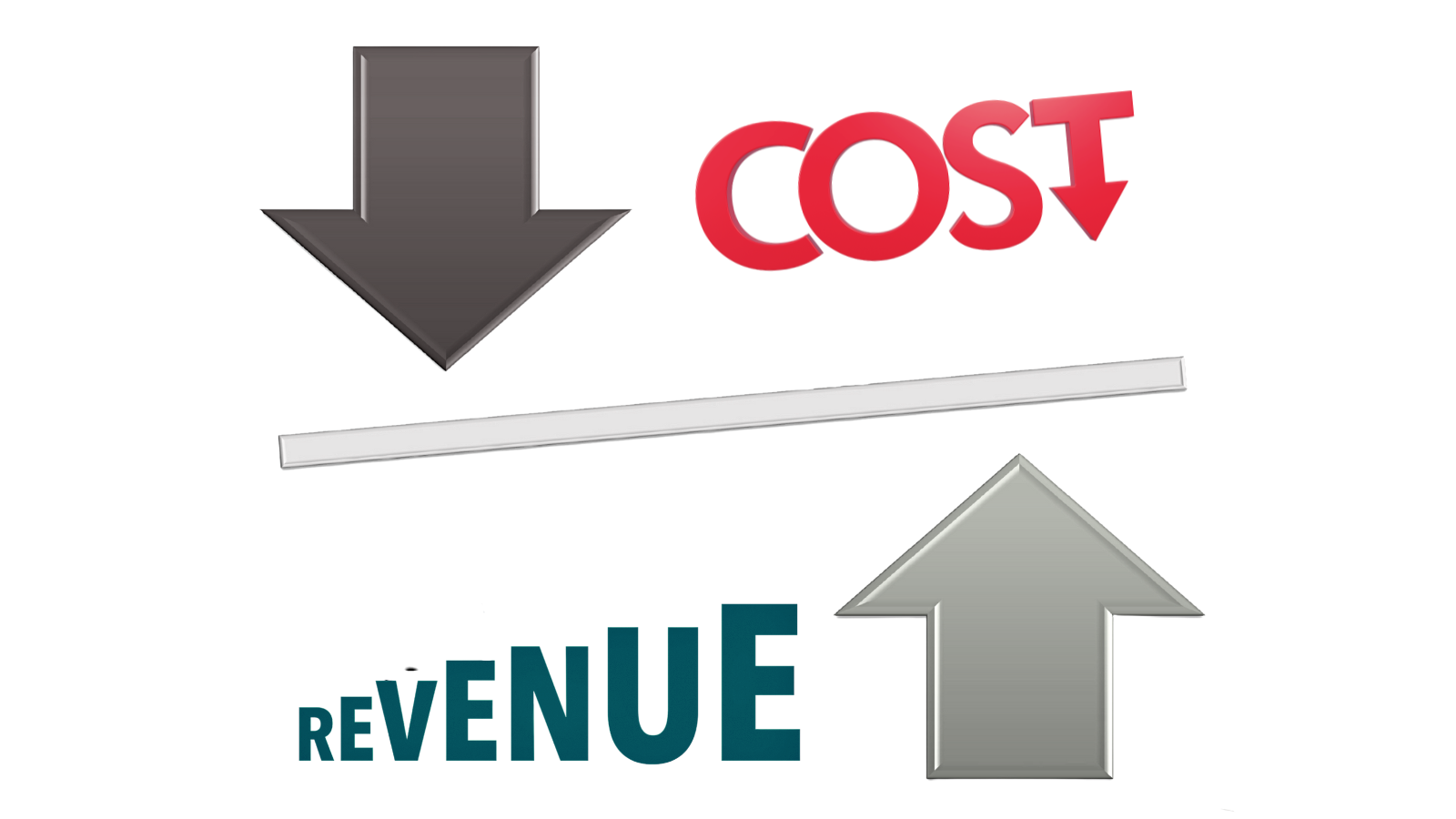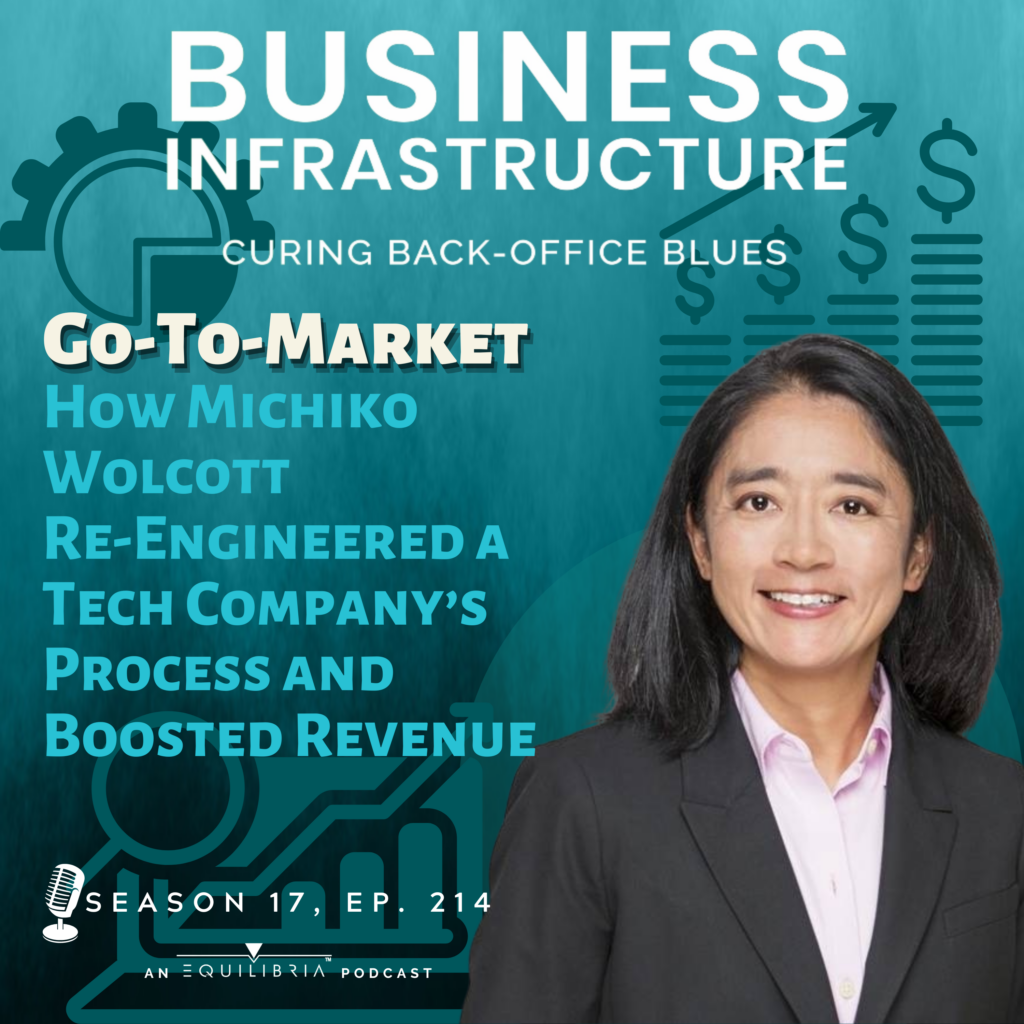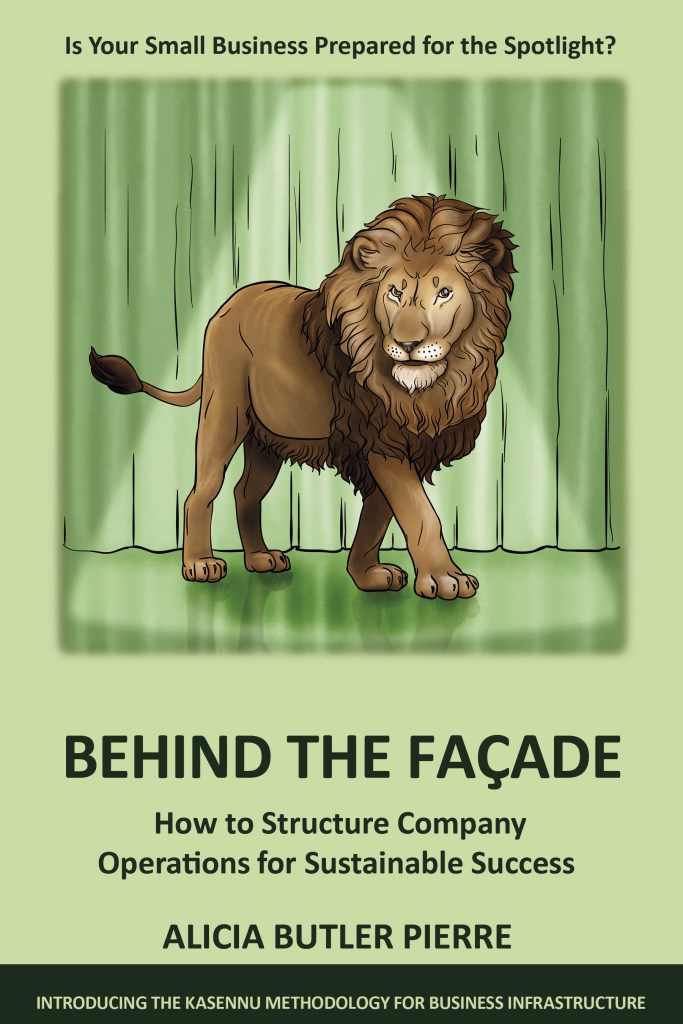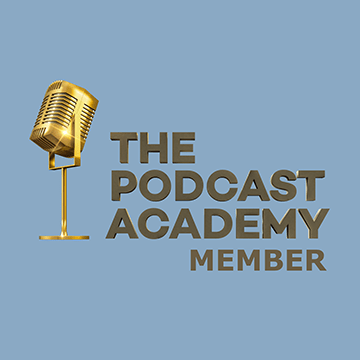Transcript
There’s a saying, “The Cobbler’s children have no shoes.” In this context, it means that we can spend so much time working to make things better for our customers that we neglect our own operations. It’s easy to be mesmerized by what technology can do for us, but oftentimes it’s at the expense of the very people and processes that also drive results.
This is the Business Infrastructure podcast – the show where we offer strategies, tactics, and resources to cure back-office blues and keep your business operating as good on the inside as it looks on the outside. My name is Alicia Butler Pierre and I’ll be your guide as we journey through this next scale tale. It comes from someone who bravely crossed the invisible line from technologist to humanist and found a way to not just toe
that line but eliminate it altogether.

This episode is brought to you by Equilibria, Inc. the company behind this podcast where we design scale-ready business infrastructure for fast-growing small businesses.
Michiko Wolcott is on a mission to “do data better.” As the Managing Principal at Msight Analytics and a self-taught process enthusiast, she knows all too well the importance of understanding a process before investing in technology and soon you’ll find out why.
This is Ep. 214: Go-To-Market – How Michiko Wolcott Re-Engineered a Tech Company’s Process and Boosted Revenue
My name is Michiko Wolcott. I am originally from Japan, I guess, long story that gets me to where I am, which is, just outside of Tampa, Florida in Clearwater. When I left Japan, on a corporate move on the account of my parents, I did move to Dothan, Alabama, which is where I learned English.
It’s also where she began to hone her skills in another language – the universal language of music.

I studied music pretty much throughout college, went to grad school, multiple music degrees, because that’s kind of what musicians do. But, I had already always had this kind of interest in the, kind of a mathy side of things. And I really liked statistics. A friend of mine talked me into going to statistics, so that’s kind of where I ended up. I got into the corporate world and, did lots of quintessential, data analysis and statistical modeling and those kinds of things, which, you know, are, a lot of things that people talk about today.
Years ago I asked a financial planner about an observation I made. Why was it that so many people with careers that involved math seemed to also be skilled musicians? “Music,” he told me, “Is mathematical.” So it makes sense that as a musician, Michiko also developed a passion for statistics and data. But, as she began to take on more leadership roles, she made a discovery that changed the way she approached data.
I had an opportunity to lead a large group of statisticians, data scientists. What have you, and then from there kind of got into more of, okay, there are things outside of actually just doing data and statistics and so forth that actually make data and analytics work. I sort of learned, by, having those executive responsibilities, but on the other hand, it’s sort of saw a lot of the human side of things, but nobody was really kind of working on, I ended up, spending a lot of time, in a management consulting firm. I, and from there I sort of decided, “Hey, I’m just going to go rogue. I’m going to do my thing.” And a lot of that was driven by, seeing a lot of opportunities or a lot of, kind of a gaps that were not being addressed at that time and data and analytics, because everybody does kind of a technical stuff.
You know the beautiful thing about entrepreneurship is that it takes many forms – while some may start businesses with a proven model, established industry, and identified customers in place, there are others – people like Michiko, the trailblazers, who venture into the unknown, hoping to fill a gap in the marketplace.
And of course, you know, I can, I have the technical background, but I just saw that the big gap was really not about people doing analytics, but really sort of how do you get people to use and consume and understand and, sort of leverage right information so that they, the user, the
consumer, the end consumer of information can do things better, not just so that statisticians can build better models. So, that’s always been my interest, for the last several years ever since I got started with my own consulting practice, and basically focusing almost solely on that kind of a human and process, you know, people in a process side as data and analytics and not so much. I’m letting all the other smart people do the, really techie side of things, that technology and the methods and, those kinds of things. I’ll let those guys, other people who are a lot smarter than I am do those things, but, I have this keen interest in trying to close that human gap, if you would, of, what it means to be successful in data and analytics.

So speaking of data and analytics, Michiko, I know you’ve described this on the podcast before what the differences are, but would you mind repeating what data versus analytics is?
Yeah. And at the end of the day, I don’t think it really matters a whole lot because they’re both information, just different forms or you do different things to it. One way to look at data is okay, that’s just, information in, super raw format, just the way it is and it’s dirty. And it does, it’s, zeros and ones and what have you. So that’s kind of one way to look at what data is. And analytics is really something you do to those, raw pieces of the data to make something, you know, a little bit more consumable to, to find out things, to, get insights from those raw pieces of data. It’s really a process or a series of methodologies that you’re applied to, raw data. And so to make it easier to consume or to get information, that’s not all that, readily apparent. But at the end of the day what comes out of analytics is also information just in slightly different format.
Now that we know the difference between data and analytics, let’s get back to how Michiko started her business, Msight Analytics, back in 2015 to explore the human side of data.
Actually, you know, I was really fortunate to, over the years have a, fairly wide network of former, colleagues and former, other connections right now, that the people I’ve met or people are worked at with, et cetera. And I’ve been just fortunate to have their trust or have their confidence. and I’ve also been fortunate to have worked in different parts of the world. Back when I was in a corporate world, I had the, the opportunity to lead a kind of an international business. And so I had a lot of connections in a lot of places. And I was fortunate enough to sort of keep in touch with those people, not burn bridges, for the most part. And, it’s just one of those things that people would start reaching out to
me once they had an issue or problem.
And so that’s kind of how I got started. I never really had to sell, which, you know, I think is I’m really, really lucky that I’ve never had to sell to get business.
Hmm…call it luck, or call it the intersection of when hard work meets opportunity. Whatever the case, as they say in business, “Your network is your net worth.”
I’m thankful for the connections and the good working relationships that, and, just network that I’ve had over the years. And so they would just come out and reach out to me. It’s like, “Hey, you know, this is the kind of stuff that we’re having problems with.” And I had a couple of really interesting breaks, that, from a contact, from a former colleague of mine, and they would come out and say, “Hey, this is what we trying to do.” “We are in a data business or we have a part of the business that is kind of like a data business. And can you help us sort of figure out why, you know, how we need to organize ourselves?” ”Where our opportunities are and where our gaps are so that we can grow? One of the big parts of this, is, that not only do they want to just grow, but they also want to be able to sort of grow in a healthy way. So that sort of gets a little bit more into scalability type thinking.
How can you not get bogged down? How can you sustain and then grow in a sustainable way and do so without getting super bogged down? Because it’s interesting, a number of clients that I’ve sort of worked with particularly the earlier years, but even now, they tend to be, information services type, you know, tech-ish companies. So they either do data for business or they have software type business they sell, either information itself or the services around information. A lot of times they’re having problems or challenges scaling or challenges growing.
How does a tech company grow and scale? We often hear about the phenomenal growth of so many of them, but how do they do it? As Michiko discovered, unlike non-tech companies that often leverage automation to scale, that’s not the case with her tech clients.

It gives us an interesting look into, okay, what does it mean for some of these other organizations to scale number one, and are there other aspects to growing sustainably and scaling? Because again, if it were all about automation, none of the tech companies would have any issues, right? But they struggle. And, so that’s kind of a clear indication that there are other sides too, or other aspects, let’s say to, to scaling.
And this is, it’s always an interesting exercise because always comes back to, you know, people and the process side of things. They, they got the tech, right. So that’s good. But, yeah, it’s, it’s the, the tech alone doesn’t make a, you know, make a business grow and doesn’t make everything run smoothly and everything, there’s all kinds of stuff that goes behind it and around it. And if you don’t have all that straightened out and then yeah, no amount of automation can, you know, make it all go smoothly. So it’s been a really interesting challenge.
I’m so glad you said that, that it’s not the tech itself that’s going to make you scale necessarily, but the people and the processes behind it. Those are the three pillars, honestly, of, of business infrastructure. It’s not just the technology, but it’s also the people and the processes.
The idea of throughput on the tech side is a little bit different in a sense that, it’s typically in terms of number of new products and releases and features and changes to the product and so on. Because they’re not really having to mass produce anything or, you know, do the same thing many, many times. So, you look for other aspects.
Those other aspects can include things like how long it takes to release new products. This is known as cycle time and it takes us to Michiko’s scale tale. It’s about one such tech company specializing in information services.
They had a process where they would take requirements to implement an analytic. So an analytic is really a result of, the output of applying analytical processes to raw data. So they had a process to get that into production. So what happens is that, you just sort of take their requirements as to how to implement this thing, and then they take those requirements and that the people will do development and, in their system and make it available to be distributed or to be accessed online. It is essentially, sort of, how it works in information services.
In analyzing their process of getting ready for production and ultimately going-to-market (you know, the moment where sales happen and money is made), Michiko noticed that it took an average of 27 weeks.
So that’s like half a year, right? It’s like half a year revenue that you’re missing. So then, you know, of course, quicker you can get that done, quicker you’re going to get the revenue in. And so, so we sent that, and then everybody’s sort of asking, well, why is it take so long? It’s so long, it takes like 12 weeks to develop an analytic, a really, you know, fairly complex analytic, but it takes 27 weeks to implement. Why is that? So, so we started kind of looking at this whole thing.
Michiko had to don her process improvement hat to answer that question – why was it taking so long to implement this process? Well, she figured it out and helped her client reduce that cycle time by 70%! Don’t go anywhere because after the break she’ll describe how she did it! And you might be surprised to hear how quick and inexpensive it was to achieve those results.
You started your business because you believed you could make a difference. But now you have more demand than you can keep up with and if you don’t get your operations in order soon, you could lose everything you’ve worked so hard to build. The chaos is causing angry customers, bad reviews, failed audits, and more. The need for a unified team with processes they can follow and tools they can use without your presence is apparent. But where can you go for support?

The Smooth Operator masterclass may be the solution you’re looking for. It’s an on-demand, online course that not only teaches you what business infrastructure is, but also shows you how to create it through video demonstrations and access to a private community where you can get even more support. Build a foundation for operational success with a scale-ready framework that’s tried, tested and true. Sign up today at SmoothOperator.courses. That’s SmoothOperator.courses.
Before the break, Michiko began telling us about the challenges some tech companies face as they scale. They definitely have the tools or technologies element of business infrastructure in place, but it’s the people and process elements that can slow down their progress. Yet, she was able to help one of her clients reduce their cycle time from 27 weeks to 8 weeks. Here’s Michiko…
That’s less than a third of the time. So if you have the same amount of time now, now you can do three of those things as opposed to like more than three of those things, as opposed to just one. And so, that was kind of the goal is that, can we get this off the shelf and available quicker?
But it’s really more about, okay, what are the process of, where are the handoffs? How many exceptions are we making? And so essentially what we ended up doing was, first of all, understand what’s going on now. And so it’s sort of like process map the whole thing and understood what was going on. But then, you know, after that, we just sat down and said with, with a team and started asking why? Why are we doing this? Why is this the document being rewritten before it’s being passed on to another person? Why are we making exception? Why did we not follow the rules?
Okay, let me break down some of these process fundamentals in laymen’s terms. A process map is a flowchart that shows all the activities performed and decisions made to achieve a desired result. As a general rule of thumb, exceptions and handoffs in a process are bad. Exceptions represent anytime there’s a deviation from the standard process or way of doing things. Handoffs represent the number of times something has to go to someone different, often for approval, within a process. And there’s also this really neat exercise in the Lean Six Sigma process improvement framework called the 5 Whys – it helps you figure out the root cause of a problem literally by asking “Why” at least five times.
And so we started asking all these why questions, just a whole bunch of brainstorming, not really pointing fingers at people, but pointing fingers at process, and, well, this is the same, this seems redundant, this seems like this doesn’t really add value to the process. So in a typical lean fashion, we’ll start to look at all the, duplication or rework and there were people that were involved, the people who were responsible and who actually did this work because they are the ones who understand, right, on day-to-day basis, what goes on. And it was actually also very important for them to get money for us to get to the, get together as a team, because it also gave us a visibility into other parts of the process where we had no idea, certain things were being repeated or certain things were in, going in giant circles.
It was basically a collaborative team effort of questioning and trying to figure out why this was a better way. Because everybody has a different perspective, but now that we all understand what everybody else is doing, then we can kind of figure out, how to better do this, because this doesn’t make sense. Or, you know, let’s figure out how to not do this, because this is stupid.
In other words, these process exercises were sparking conversations necessary for figuring out how and where improvement opportunities existed.
So we would get into these exercises and it was, really interesting. I work with, data people, and sometimes they have processes, well a lot of times, they do have processes. And sometimes we don’t always take a step back and look at the whole picture of what we’re doing and why we’re doing what we’re doing. And, it’s not the people, it’s not the person, the specific individuals in the process that are, causing certain things. It’s really just that the system in which they’re doing their work, that it’s really, poorly designed. You have to make sure that the process, is set up well so that people are not set up to fail. You know, people in it are not set up to fail.
One of my mantras is “Blame the process before you blame the people.” If the inconsistency in how your products and services are delivered continues to rise, then it begs the question – what does your process look like? If there isn’t one or it isn’t documented, then you can’t justifiably blame people when things go wrong. This leads us to one of what I call, Michiko’s Musings. The first of which is that a process is really just a series of decisions.

Yeah. Our days are really full of everyday decisions, we kind of take them for granted because they’re so part of what we do every day, but they’re there and we make decisions whether we are consciously making decisions or not. And so I’ll put a one decision sort of fall feeds into another decision and so forth. Once you start kind of thinking through, okay, there is an order in a structure to all these decisions that we make, it’s basically a process. And so looking at it from a reverse, if you look at a process, each activity has an input and an output and it’s sort of all go somewhere or it’s supposed to go somewhere. You can look at input, as, okay, you’re taking in information and output as a decision.
Maybe it only has one arrow coming out of that, you know, a box, but it’s still a decision, nonetheless. I mean, you can always not do it. So then you can kind of look at a process that way that, there’s something that goes in that you do something, some activity, and then something comes out. That’s something coming out is essentially a decision that you make. You’d make a decision to hand it off to somebody. You make a decision to move on to the next step. And so once you start looking at processes that way, then it becomes really kind of interesting. Then you look at sort of process improvement from a slightly different perspective.
Basically, processes work when they are performed as documented. If you decide to make an exception in following a process, then that’s where problems can arise.
Exceptions are basically, you stop your normal process. The problem with exceptions is that you have to stop, it brings you to a full stop. A lot of times I think we make exceptions in the name of flexibility. It’s like, well, this case is a little bit different.
Left unchecked, exceptions or variations can wreak havoc. Of course, there will be times when a process may have to be broken but those instances should be the exception (pun intended) and not the rule. In fact, Michiko has a solution for this.
Just count the number of exceptions you’re making. If you’re making exceptions more often than following the, the process, then, yeah, we’re going to want to look at that. I’m a big abuser of the 80/20 principle. And, again, because there’s no such thing as a hundred percent, you know, exception-free process, I’d say, if you are dipping below 80% in the use of standard process, then I think there’s something that we need to look at now, of course, in some cases it needs to be a lot higher, but generally speaking, you know, if, if you’re making exceptions of more than 20% of the time. Yeah. I think that’s a problem.
Michiko has other musings of course, but we’ll save those for later. For now, let’s get back to her scale tale. It might surprise you to hear that her information services client made no additional investments in headcount or technology. Aside from Michiko’s consulting fees, in true Lean Six Sigma fashion they worked with the resources they already had to figure out how to reduce waste and errors in getting their products to market faster. So, how long did it take to achieve this result?

Once the current sort of process was mapped out, I wanna say that we probably had about 15 hours total of just kind of looking at poking holes to the current process and that happened probably over a span of, four to six weeks. Again, we didn’t want to pull people off too much, from their day-to-day kind of operations. And also it’s kind of useful to have a little bit of time in between thinking, kind of let it steep a little bit, let it brew a little bit and then come back and rethink certain things.
So it’s not a whole lot, but what it did require was kind of, everybody’s willingness to look at what they’re doing and how they’re doing it differently. And their willingness to kind of work with each other and willingness for things to be better. And we were very fortunate and lucky where we didn’t have a whole bunch of conflicts, at least not overly, outwardly anyways, where everybody was actually really engaged and involved in a process. But again, not a whole lot of time on, in terms of effort, time, and no additional investment, everybody’s sort of carved out a little bit of their work time to get this done.
I’m thinking to myself, this is a sweet deal for the client because zero investment, aside from investing in your services, to help them go to market faster, which accelerates revenue. So I can only imagine the level of scale that they’ve been able to accomplish by replicating, not just what they were able to achieve as a result of a process scrub, if you will, or improvement in that area. But I can imagine seeing the results there has encouraged them to maybe analyze even more processes and other parts of their company as well.
Absolutely. And I have another client that I worked with, also an information services that worked almost exactly like that. And it’s really funny because particularly when the organizations get a little bit larger, you don’t always see everybody else. You kind of tend to work in your own cubicle and silo, you don’t really interact with other people and you sort of lose sight of where you are in the entire kind of value stream, right, of what it is that we’re producing. And, it’s interesting that the problem has always been with not with the technology and not with the, the tools and not with hardware, but with people.
I don’t mean individuals have problems, but I mean, like this is a people problem, largely at least largely a people problem. And it’s to the point that it has even completely changed the culture and some of these client organizations and I mean, culture, not identity, right. The idea still have the identity, but the culture around that identity has shifted so much that they used to all work in silos and now they’re very collaborative, super open it’s, it’s kind of really neat to see that, that, you know, human trans assignments, you know, the, the organizational side of transformation, even though these are tech people. And even though we never introduced any sort of like new tools, right, for the purpose. I’m always fascinated with how people think and how people function, you know. What makes them tick and despite the fact that I’m, you know, sort of coming from a little bit more technical background, And these exercises, I find them super fun and very rewarding.
Seeing transformation because of an effort you’ve led is indeed rewarding. Let’s give it up for Michiko Wolcott. Believe it or not, she’s self-taught when it comes to process documentation. And in case you’re wondering what resources she relies on to learn more about the human or organizational side of process transformation, there’s two books she recommends. Lean Thinking by James Womack and Daniel Jones and Out of the Crisis, by one of the pioneers of Total Quality Management, W. Edwards Deming. We’ll have links to these books, the full list of Michiko’s Musings, as well as how you can contact her on our website at BusinessInfrastructure.TV.

Thank you so much for listening! If you enjoyed this episode, then you’ll really like our next scale tale. It features a serial entrepreneur on the other side of the world whose making waves scaling breweries around the world. Be sure to subscribe to the show so that you don’t miss it!
And while you’re at it, leave a five-star rating and review wherever you’re listening. Growing and scaling a business is no small feat, but remember, Stay focused. Be encouraged. This entrepreneurial journey is a marathon and not a sprint. Until then, keep operating smoothly as you work to cure your company’s back-office blues.
This episode was written, produced, and narrated by me, Alicia Butler Pierre. Audio editing by Olanrewaju Adeyemo. Original score and sound design by Sabor! Music Enterprises.
This is the Business Infrastructure – Curing Back-Office Blues podcast.

















